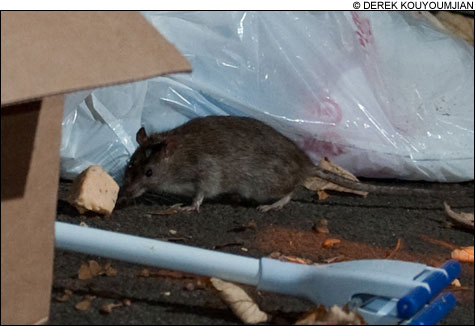Residents say that if you jam a leaf blower in the earth virtually anywhere in Allston, furry bottom feeders will be blown out of every crack and hole in sight and rain down like unsavory screeching meatballs. North Enders joke that something similar would happen if you detonate a Parmesan wheel in an alleyway off Hanover Street. Regardless of the variety of horrific, apocryphal rodent tall tales, what’s constant is that Boston is suffering through a very real rat infestation, one that is gnawing on nerves from Beacon Hill to Brighton.
While many publications (including this one) have previously wrung hands about the gravity of the problem, none has yet connected the droppings between the global financial collapse and the rise of these perpetually reproducing and diseased underground adversaries. Crater-like gashes in the ground in Downtown Crossing and in Allston-Brighton— sites of already initiated and now-languishing projects for, respectively, Filene’s and an expansion by Harvard — have displaced rat colonies into the surrounding areas and, depending on who you ask, nurtured or even accelerated the scourge. As the ongoing economic landslide further extends the duration of construction projects — with more and more foreclosured and abandoned properties making it harder for planners and exterminators to combat pestilence— anecdotal and empirical evidence suggests that Boston’s rodent problem is only getting worse.

Residents and business owners are growing increasingly frustrated; the number of rat-related complaints to the city’s Inspectional Services Department (ISD) has increased by nearly 20 percent from 2005 and more than doubled in the past decade. That proliferation makes sense, considering that in 2007 two of America’s leading rodent researchers — both of whom handled pest-control management during the Big Dig— labeled Boston as one of the three US cities most vulnerable to infestation (their research identified factors including weather, human density, poverty, and infrastructure-maintenance spending). And that was before the crumbling economic cookie scattered further crumbs throughout the metropolitan area.
Ten years ago, though, experts predicted Boston would be virtually rodent-free by 2005. At the time, even despite ongoing construction, the number of reported rat sightings was reaching record lows, with just 647 calls to ISD in 2000. (This is largely attributable to the more than $1 million annually dedicated to prevention back then.) Unfortunately, Boston scaled back its then–relatively successful course of action, and municipal decision-makers failed to fully fund and follow the treatment prescribed by consultants who nearly purged the subterranean landscape of undesirables in the late 1990s. To witness the frightening resultant upsurge in the rat population here, one simply needs to walk through the Bean’s cramped districts on the night before trash pick-up.
 |
Allston’s rats, not Harvard’s
This story begins in Allston, where the looming Harvard science complex is an open wound, and where it’s all too common to catch rats marching on late-night spoils parades in the Blanchard’s parking lot. Legend has it that the number of rats here outnumbers that of hipsters and college students combined. (In reality, experts are reluctant to estimate the number of neighbors beneath our floorboards, but will nonetheless confirm that, if you’re in an urban setting, rats are probably fornicating within a few feet of you.)